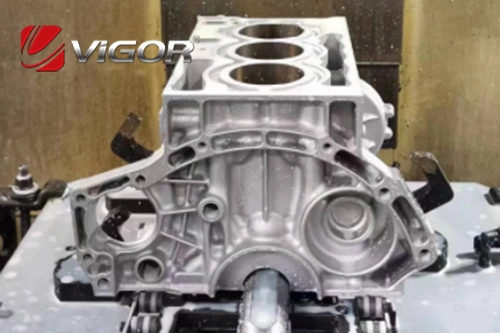
Knowledge
Types of Die-casting Processes

Hot chamber die casting
Hot chamber die casting is a time-honored die casting technique characterized by the direct immersion of the injection mechanism into the molten metal. This process is suitable for low-melting-point metals such as zinc, tin, and lead alloys.
Process features: Hot chamber die casting machines have high production efficiency and fast cycle times, reaching up to 15 cycles per minute. Due to the direct contact of the molten metal with the injection mechanism, this process is easy to automate and the metal melting process is simple and convenient. However, the long-term immersion of the injection chamber and injection hammer head in liquid metal limits the clamping force of hot chamber die casting machines, usually not exceeding 400 tons.
Metal liquid temperature control: In hot chamber die casting, the temperature control of the metal liquid is crucial for product quality. Excessively high temperatures can lead to metal oxidation, increase the iron content in the alloy, and affect the quality of the castings.
Mold design: The design of hot chamber die casting molds needs to consider the fluidity and filling characteristics of the metal liquid, and is typically used for the production of small castings.
Cold chamber die casting
Cold chamber die casting is in contrast to hot chamber die casting. Its characteristic is that the molten metal is only poured into the injection chamber just before the injection, rather than remaining in continuous contact with the injection mechanism.
Process features: Cold chamber die casting is suitable for high-melting-point metals such as aluminum, magnesium, copper and their alloys. The cycle time of this process is longer, but since the molten metal does not directly contact the injection mechanism, it can reduce the oxidation of the molten metal and the wear of the mold.
Injection pressure: The injection pressure of cold chamber die casting machines is usually between 2000 and 20000 psi, much higher than that of hot chamber die casting machines. This enables cold chamber die casting to produce more complex and thin-walled castings.
Mold life: Due to the lower temperature of the molten metal, the mold life of cold chamber die casting is relatively longer, but the manufacturing cost of the mold is also higher.
Vacuum die casting
Vacuum die casting is a special process that involves removing air from the mold cavity during the die casting process to reduce porosity within the castings and enhance their mechanical properties.
Process advantages: Vacuum die casting can significantly reduce the porosity rate within castings, increase their density and mechanical properties. This process is particularly suitable for producing castings that require high strength and airtightness.
Vacuum control: Maintaining an appropriate vacuum level is crucial during vacuum die casting. Typically, a vacuum level of 50 to 80 kPa is required to effectively remove gases from the mold cavity.
Production efficiency: Compared to conventional die casting, the production efficiency of vacuum die casting is almost the same, but due to the need for additional vacuum equipment, its cost is relatively higher.
Squeeze casting
Squeeze casting, also known as liquid die forging, is a process that combines the characteristics of casting and forging. It involves applying pressure to make liquid metal crystallize and solidify in a mold while undergoing plastic deformation.
Process features: Squeeze casting can eliminate defects such as shrinkage cavities and porosity inside castings, enhancing their density and mechanical properties. This process is particularly suitable for manufacturing high-strength structural components.
Application scope: Squeeze casting is applicable for producing castings of non-ferrous alloys such as aluminum and magnesium alloys, and is widely used in the automotive and aerospace industries.
Production efficiency: The production efficiency of squeeze casting is lower than that of conventional die casting. However, due to its ability to produce castings with properties close to those of forgings, it has irreplaceable advantages in certain high-demand applications.
Vigor team have rich experience on die-castings. If any question or any demands we can help, please feel free to contact us at info@castings-forging.com



